March 20 - 26, 2016: Issue 256
The Pilliga Push: March 2016
The Pilliga Push, March 2016
An account of the experience of observing first hand the push to end CSG mining in the Pilliga Scrub, by Dick Clarke.
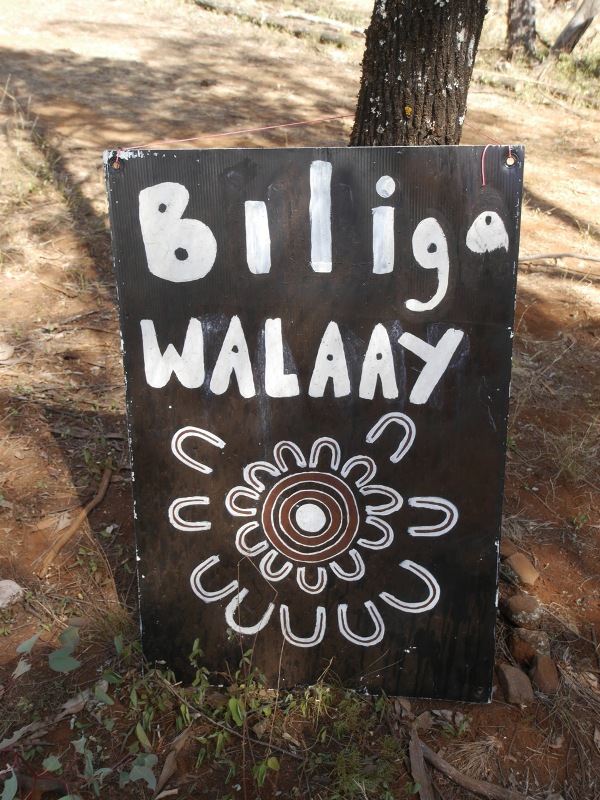
GAMAROI WELCOME SIGN
THE PILLIGA PUSH CAMP
The evening is warm - hot, many would say. The day was unarguably hot, in the mid 30s. I am sitting in my camp chair, eating a cold salad dinner with my wife, under a sparse and patchy tree canopy in a dry bush camp just off the Newell Highway, 35kms north of Coonabarabran in north western NSW. There are couple of dozen camps within this larger camp, an assortment of tents and tarps, campervans and a caravan, gathered around a large and well provisioned solar powered kitchen tent and communal area. This is the perfect picture of human self-organisation, even if not the most architecturally elegant creation ever. But that’s the point: this camp is not here because it’s a picturesque location, it’s here because it’s an important location, and it’s under threat. And this disparate crew have self-organised in an attempt to protect it. The camp infrastructure has been constructed under the creative guidance of a talented young bloke called Dan.
This is the Pilliga Push, in the Pilliga Scrub. It has seen the coming together of three groups who used to see each other as enemies: local Aboriginal communities, diverse environmentalists and farmers. Once they saw each other as either ‘ferals’ or ‘the squattacracy’, but now they are jointly stewards.
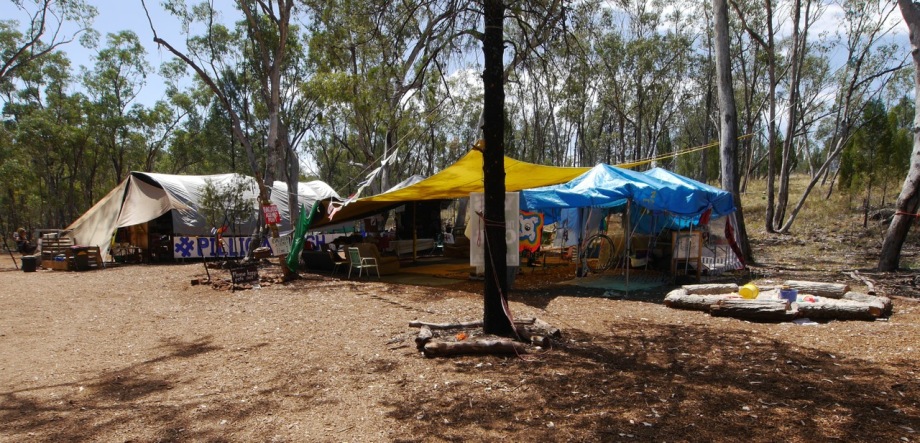
THE PILLIGA PUSH CAMP KITCHEN AND COMMUNAL AREA
For a pair of Sydneysiders with busy work lives, and all the usual commitments of family and friends, it can be hard to engage with serious ‘activism’, no matter how fervently you believe in the cause. In our case, we are firmly convinced of the scientific evidence for human induced climate change, and are painfully aware of the impacts of coal mining and coal seam gas mining on aquifers and productive agricultural land. I come from a long line of farmers, and we have farming relatives on both sides of the family, including in the New England of NSW, near the uber-productive Breeza plains. As a building designer, and years ago as a builder, I have had a long running love affair with cypress pine (several callitris species), because of its natural warmth, longevity, termite resistance, and importantly, its sourcing from this very forest. I also confess to being a ‘cypress aroma junkie’ – anyone who has worked with the timber knows its enticing aromatic qualities. And, it is just so Australian. Having spent my early childhood in Dubbo, with many trips to Coonabarabran and the Warrumbungles, I have a sense of stewardship of this region’s nature, even though the timber industry is vastly reduced from its heyday. My interest in what’s happening in the Pilliga is several layers deep.
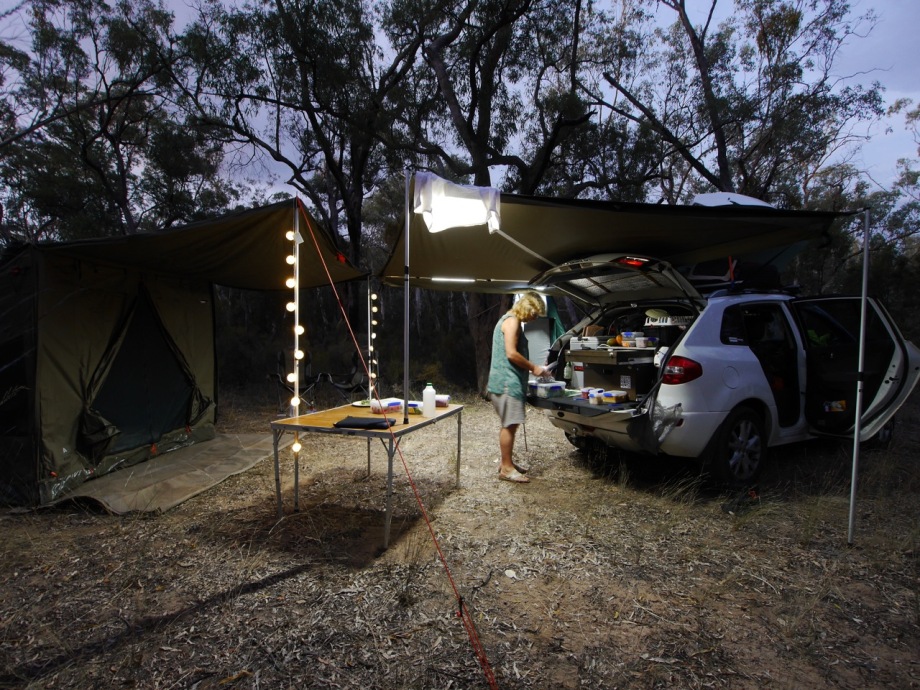
PREPARING DINNER ON A HOT NIGHT IN CAMP
Santos also has an interest in the Pilliga that is several layers deep – about a kilometer deep in fact. Santos is drilling for coal seam gas in the Pilliga, and constructing significant supporting infrastructure. 850 wells are planned, with 56 already drilled, of which 36 are operational. CSG fracking involves pumping a cocktail of chemicals down the drill hole, which causes the rock containing the gas to fracture (thus the term ‘fracking’), releasing the gas, mostly methane. When released, the gas pushes back most of the toxic fluid that was pumped in, along with any water and other materials naturally trapped in the rock, some of which are also toxic and radioactive (1). This toxic flowback water, called “produced water”, must be contained somehow, and either trucked away for ‘treatment’ (but then what?), or evaporated on site. In NSW evaporation ponds are illegal, so any pondage is notionally a holding tank, while treatment is organised elsewhere. Of course, in the hot dry climate of the Pilliga, a lot of evaporation will occur while the fluid is being held in the ponds.
Another concern is the losses of chemicals and fluids during the fracking process – not all of it flows back up. Where does the rest go? The concern is that it seeps into aquifers, permanently polluting these critical sources of artesian irrigation water. The current accounting methods are not accurate enough to be sure how much is seeping away, but logic dictates that if the drill passes through a strata containing water, then the pressure of the process will result in a proportion being diffused into that aquifer. The Pilliga is a prime charging point for the Great Artesian Basin, whose waters percolate slowly through a myriad of little understood structures, for the benefit of farming and towns in outback NSW and central Australia (2) . Any contamination of these waters will not be evident for generations – long after the current Board and management of Santos are dead and buried.
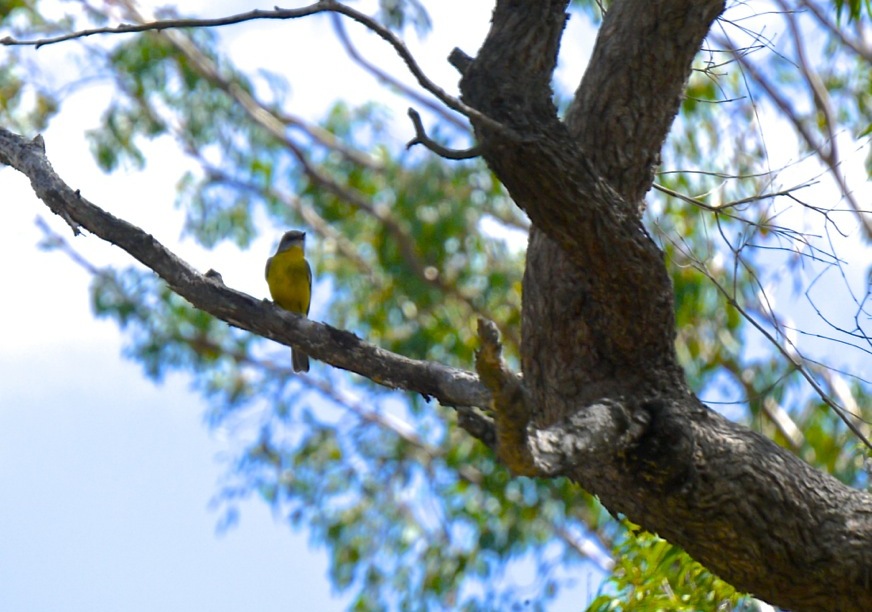
EASTERN YELLOW ROBIN WATCHES OUR CAMP
In contrast, AGL has withdrawn from all CSG exploration in NSW (3), in what may be initial moves towards an exit fossil fuels altogether. That’s vision and leadership - hopefully it will not fall victim to the kind of quarterly profit reporting that saw BP give up on its own mandate to become Beyond Petroleum.
THE SMART YOUNG ACTIVIST
I wander up to the kitchen tent where most residents here share meals. We are self-catering in our self-contained camper, partly because I don’t want to be a burden on this voluntary social phenomena, but also to maintain a degree of independence and impartiality. Naomi Hodgson is attending to messages on her mobile (yes there’s coverage!) as we settle in for a long chat. She is The Wilderness Society’s campaign manager for the Pilliga, and so I discover the beginnings of a structure to this phenomena, and yet she has no way of controlling, or even predicting, who will show up to help, or when. It really runs on the awareness and passion of individuals who connect through friendships, Facebook, Lock The Gate or Land Water Future – itself a phenomena of self organisation, where 75 community, farming and environmental organisations came together to specifically fight what they see as the onslaught of coal mining and CSG into prime agricultural land and sensitive water sources (4).
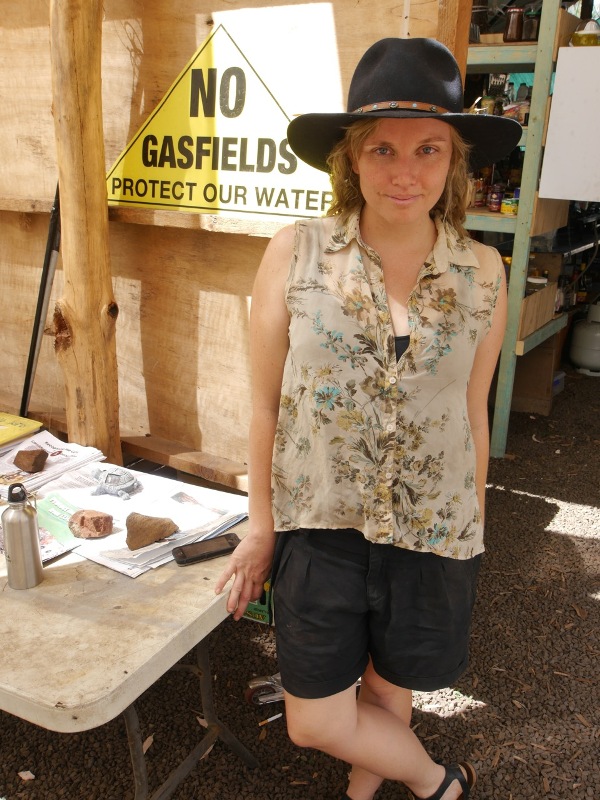
THE WILDERNESS SOCIETY’S CAMPAIGN MANAGER NAOMI HODGSON IN CAMP
Naomi tells me that each well clears a patch of land 100 metres square, plus the roads, pipelines and holding ponds. Santos controls about 98,000Ha of the Pilliga, and if they proceed with their plans, about one fifth of the Pilliga’s 500,000Ha will be directly affected, with about 1,000Ha completely destroyed. I try to equate that to an area that makes sense to me: if a modest suburban block of land is 500 square metres, that’s 20,000 of those lots. That’s half a dozen suburbs, or several country towns. Naomi says the even scarier thing is that Santos have a further 6 gasfields planned across the region, from the Liverpool Plains to Narrabri.
Playing the devil’s advocate, I ask her “So what?”
“Have you seen the patchwork that has scarred south east Queensland?” she asks. I nod in mute agreement – it certainly doesn’t look good. But looks aren’t everything, even though properties in parts of the Condamine in Qld have dropped in value so much, some are considered unsellable (5) – are there any impacts beyond what can be seen?
Naomi starts on a long list of measurable impacts. She says that surface water in the Pilliga has been affected by at least twenty reported leaks, and probably more unreported ones. These include the discharge of highly toxic and saline ‘produced water’ into creeks, containing uranium, arsenic and cadmium. Pond liners have leaked,contaminating an aquifer with uranium, arsenic and cadmium - even the new “state of the art” ponds like the newly constructed one at Leewood (6), scene of the latest round of lock-ons, which leaked during commissioning. “Twenty leaks just in the so-called exploration phase are not “anomalies”, these are systemic failures that could go unnoticed when the eyes of the world are not on them like they are now” she says. “It should not be up to the community to monitor ongoing risk, and when that risk is replicated at scale it becomes unmonitorable. This is the experience from Queensland and internationally.”
“Ground water is the next impact zone for CSG” says Naomi. She says that depressurization of the Great Artesian Basin (GAB) is a known risk, and that the Pilliga is part of the recharge zone for that immense slow moving body of water. Overlying the GAB are several smaller localised aquifers, whose interconnectedness is certain, but poorly understood (7). “Santos’ own assessments admit that the Gunnedah-Oxley Basin is likely to suffer significant impacts and depressurisations,” she explains. “And then there’s the contamination risk from fracking fluids either during drilling or when wells break down over time.” The products of fracking include those radio-active substances as well as naturally occurring BTEX (benzene, toluene, ethylbenzene and xylene) chemicals normally safely locked away a kilometer underground.
THE CAMP KITCHEN THAT DAN BUILT
The Leewood water treatment plant, just south of Narrabri, is intended to include an energy-intensive reverse osmosis system that will remove most salt from the briny solution, but this cannot remove BTEX or radio-nucliides. At the end of the exploration phase, before any truly commercial production begins, there will be 500 megalitres of salty contaminated residue, for which there are currently no plans for disposal or further treatment (8).
“The EPA had withheld approval of the exploration license because Santos could provide no viable solution to this toxic legacy, and they explicitly stated that until such a plan was forthcoming, no approval would be granted. Yet just one month later, with no plan and no explanation, Santos got its license.” said Naomi.
THE ANGRY FARMERS
The Kennedy family have been farming near Coonamble on the western side of the Pilliga for five generations, and Ann Kennedy, now 68, with 13 grandchildren, is extremely worried about the threat of CSG. Ann is President of the NSW Artesian Bore Water Users Association, President of the Great Artesian Basin Protection Group, and on the committee of the Great Artesian Basin Advisory Group. She says, “I am painfully aware that farmers in our region are entirely dependent on the groundwater of the Great Artesian Basin. We have absolutely no other source of water. Our groundwater is all we’ve got.”
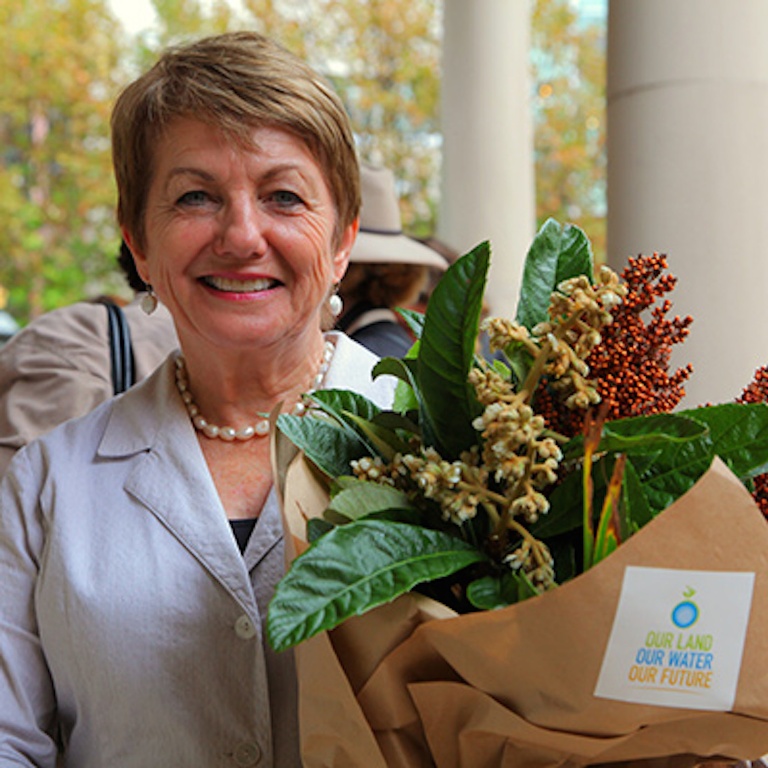
FARMER ANN KENNEDY AT 2015 COONAMBLE AUSTRALIA DAY CEREMONY
The Kennedys are so concerned that even though there is no immediate threat to their property, like Wallaby captain David Pocock and his father, her husband Neil has put his body on the line in an attempt to stop Santos in its tracks. In early February, this not-so-young conservative farming man locked on to the construction site gates and sat there for hours, while Santos security filmed his every breath(9). Ann goes on, “I am one of the people that the NSW Resources Minister was describing as an ‘eco-fascist’ this week... I must say I’ve never been called anything like that before. Last year I was named Coonamble’s Australia Day Citizen of the Year, …it meant Coonamble Council and community valued so highly the work I am doing trying to save our artesian water.”
Like Naomi Hodgson, the Kennedys are also concerned about safety for families, and are incensed that land owners have no right to say ‘No’ (10).
Traditional owners’ sovereignty has also been over-ridden. The Gamaroi people are vehemently opposed to CSG mining on their land, and have been outspoken in making this very clear to both Santos and the NSW Government. In Narrabri, where Santos have their regional headquarters, old friendships have been strained and broken by polarised allegiances (11), and every local I spoke to doesn’t want that to happen in Coonamble or Coonabarabran.
A number of people I speak to make a very clear and critical point: there is no need to mine for CSG, there are cheaper alternatives from renewable energy now (12). And the weight of scientific opinion tells us that we have to leave almost all of the remaining reserves of fossil fuels in the ground if we are to have any chance at all of limiting global temperature increases to manageable levels. It looks like the aspirational target of 1.5° of warming since the preindustrial era is already a pipe dream (13), but every little bit will help keep it nearer that limit.
Tim Buckley, of the Institute for Energy Economics and Financial Analysis, whose job it is to analyse global energy markets, says that the return on investment isn’t there in any case, and that Santos, like all fossil fuel mining companies, is on its knees in the capital markets (14). Its share price has taken a beating, and it recently wrote down the value of the Pilliga project by $800m (15) . Part of the story probably lies in the curious number of wells that have been drilled and capped off, indicating a less productive field than anticipated. Several commentators have noted that Santos are serious when they say they will not be investing any more money in the Pilliga operations. So why the intense efforts to keep construction happening on the ground?
THE CYNICAL OLD ECOLOGIST
When Santos’ recently departed CEO David Knox made his initial claims about the size of the gasfield, he led the markets and financiers to believe that it was “bigger than Ben Hur”, according to David Paul, an ecologist and long time local. We call on David’s farm in the southern Pilliga on our way to the Coonabrabran Show, on Saturday afternoon. The problem, says David, is that unlike coal or iron ore, it is impossible to accurately estimate the size of a gasfield prior to drilling. The reason so many of the drilled wells have been capped off is that the gas is simply not there in sufficient quantities to make it worth getting out. This, he reasons, is the subtext in Credit Suisse’s analysis of a “poor production result”. He suspects that Santos are in such a hurry because they need to get the project to a point where it is possible to sell it. “In fact,” he says, “they have probably already progressed through early discussions with one or more suitors, and you can bet your bottom dollar the NSW Government know all about it.”
David Paul’s career as an ecologist has seen him work on both sides of the fence – both for and against mining – including many years toiling away on surveys of the biota of the entire Pilliga regions. He was instrumental in discovering that the famous Pilliga mouse, thought to be extinct, is alive and kicking. He also found a strong and vibrant population of koalas nearby, although with subsequent disturbance, these haven’t been seen for two years. I get the feeling that David’s recent stand against CSG has earned him a share of enemies in the Santos and NSW government camps, but he feels he is of an age where such things are less important than standing for what he believes to be true and just. He is particularly scathing of one-time Deputy Prime Minister John Anderson’s jump from National Party politics to Executive Chairman of Eastern Star Gas, Santos’ predecessor in the Pilliga (16). He explains to me that although the Pilliga contains some State Conservation Areas, these are not sacrosanct, and can be mined just like a state forest can.
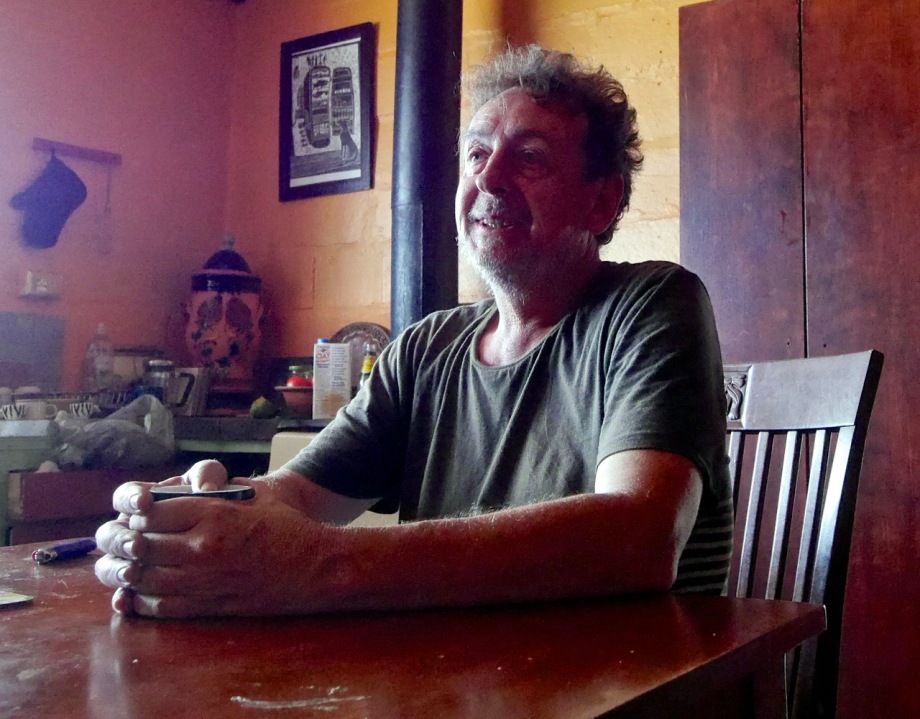
ECOLOGIST DAVID PAUL AT HOME IN THE PILLIGA
David is a walking encyclopedia of the history of government agencies and CSG in the Pilliga. His time as a young man working for the NSW Forestry Commission gave him an early understanding and love for the ecology of the place. “Ecology is not just plants and animals, it’s about human connectedness too.” Yet human activity in developing CSG has shattered those connections, he says, outlining a potted history of spills and disasters: “In 2011, Eastern Star had a turkey nest holding dam, one that sits above ground with earth walls. It collapsed, and the resultant spill ran away into the forest. Five years later it’s still a toxic wasteland there. This event led to them being required to do an REF [Review of Environmental Factors] after the event, but this is not a full EIS [Environmental Impact Statement] – it’s just a notional review of things that might be at issue.” Clearly some of them are!
Fast forward several leaks and incidents to 2012: “Bibblebindi water treatment plant had a spill into Bohena Creek, and they were issued a $3,000 fine.” They had more leaks in 2014 and 2015, with even lesser fines. I must admit, these seem disproportionately small in relation to both the damage and the size of the corporation involved. Bohena Creek is not looking healthy, according to David Paul and other locals. Like The Wilderness Society, David reckons the biggest risk is to water, specifically shallow aquifers. He reiterates the fact that the Pilliga is in the Great Artesian Basin’s recharge zone, and that the actual structure and internal connections of the GAB and all of the shallower localised aquifers is extremely poorly understood. This is supported by local farmer Tony Pickard, whose bores were contaminated by a sulphur-eating bacteria commonly found in coal seams (17). How did it end up in bore water? No one has a definitive answer, but the precautionary principle should definitely apply here.
David and Naomi have both pointed out that Santos are operating without proper approvals. That is, they are building a commercial gas production and processing facility by stealth, allows a piecemeal approach to development and approval, before the full EIS is even submitted or assessed. They do this by treating each stage as a separate exercise in “exploration”, when in fact all of these so called stages are part of one big plan. This is explicit in their corporate plan, yet the NSW Government accepts these piecemeal deceptions at face value. The whole project should be considered together, and as such would require an EIS. Without this, the whole project is operating without the necessary approvals – and this is at the heart of the protestors’ case.
The Environmental Defenders Office of NSW (EDO NSW) is currently representing an organisation called People for the Plains in the Land and Environment Court against Santos and the NSW Government (18). The case hinges exactly upon this lack of an EIS as required by the Petroleum Onshore Act. Santos claims its construction of the massive water treatment plants are “ancillary development” and therefore do not require an EIS. The Leewood pondage covers 28 Ha (19), and it is integral to the production process, therefore simple logic dictates it is not ancillary but critical infrastructure.
THE ANNUAL COONABARABRAN SHOW
In the afternoon we end up at the Coonabarabran Show – it’s that time of year when all the rural communities prepare for the big one, the Sydney Royal Easter Show. As we drive down the Newell Highway, passing B-Double after B-double heading from Melbourne to all points north, I wonder how many city people remember where The Easter Show has its roots. Indeed, I wonder, in the case of Sydney, where so few venture beyond The Sandstone Curtain (the Blue Mountains), how many people really understand how connected we are to the land for food and water, and how much our hunger for fossil fuels is threatening that connection. Humans are their own worst enemies, there’s no doubt.
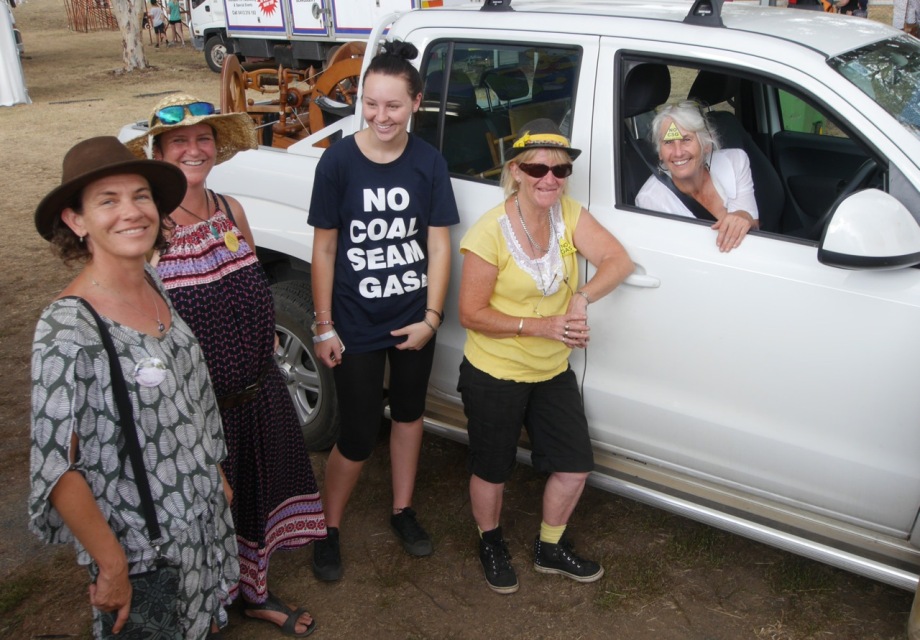
KNITTING NANNAS YOUNG AND OLD, WITH A UTE LOAD OF SPINNING WHEELS, AT THE COONA SHOW
The Coona Show is a happy milieu of big hats, happy kids, and noisy sideshows with their attendant showies, cigarettes hanging from corners of loud mouths. Beyond Sideshow Alley with its booming music and garish colours, is a row of agricultural and produce pavilions, cattle, jam in jars, girls in jodhpurs tending shining horses, horse floats, and the rowdy joy of the bar serving ice cold beer on a hot and unusually humid afternoon. There’s also a humble little stall proclaiming the need for a gas-free Pilliga, manned by a Knitting Nanna, alongside Naomi from The Wilderness Society, a handful of volunteers from the Pilliga Push camp, and a conservative looking chap by the name of Peter Small, dressed in the uniform of the country bloke, a pale blue shirt. He’s talking to a very animated local, Steve Wallace, about fire risk.
 talks to Steve Wallace about CSG fire risk at the Coona Show1.jpg?timestamp=1458185632755)
PETER SMALL (ON LEFT) DISCUSSING THE FIRE RISKS OF CSG WITH LOCAL VOLUNTEER FIRE FIGHTER STEVE WALLACE
Steve is a volunteer fire fighter, who is incensed that Santos has an exemption from fire bans – even from total fire bans on 40+ degree days with high winds(20). The problem is that some of the productive gas wells have a large flame, as high as 4m, flaring off unwanted gases. These burn 24/7, summer and winter. Steve is going ballistic over the risk he perceives these wells pose in starting fires, and also in exploding when attacked by fire. Peter Small is a mechanic at the nearby Siding Spring Observatory, and also an experienced fire fighter, and agrees with Steve, “It seems there is one rule for Santos, and another for everybody else.” How this situation came to be intrigues me. When pushed, everybody I have spoken to suggests it is an unhealthy relationship between the old guard of the fossil fuel industry and the revolving door of state and federal ‘party hacks’ who either become ministers(21), or stand behind them pulling their strings. If this is true, then we get the governments we deserve, as long as we keep voting for either of the two major parties.
Siding Spring Observatory is one of the world’s preeminent optical observatories, with a long waiting list of the world’s best astronomers queued up to have a peek through on its $110m worth of telescopes. It is owned and jointly operated by the Australian National University. Santos’ gas flares will add a damaging amount of light pollution to the district’s currently dark night skies, destroying the value of this expensive installation (22 . Yet another Australian high-end knowledge pool would be neutralized by a low-grade fossil fuel industry. This is what motivates Peter to stand all day in the heat at the Show, talking intelligently to all comers on the dangers CSG poses, on so many different fronts.
THE CSG FAERIE AND THE KNITTING NANNAS
Back in the camp, I meet youthful grandmother Sharon Klein, whose alter-ego is the ‘CSG Faerie’. Arrayed in her rainbow coloured wings she has become a regular sight at events designed to attract the world’s attention. Originally from western Sydney, and more recently far north Queensland, and now more transient in her small motorhome, this highly trained theatre nurse and intensive care specialist alternates between caring for her aged parents in the Blue Mountains, and helping out at the Pilliga Push camp. She was present at a recent action where another pair of grandmothers, two of the now famous Knitting Nannas Against Gas, locked on to a machine at the Leewood water treatment plant worksite.
YOUTHFUL GRANDMOTHER AND ‘CSG FAERIE’ SHARON KLEIN BESIDE HER MOTORHOME AT THE PILLIGA PUSH CAMPSITE, FAIRY WINGS AT THE READY
It was the searingly hot first day of February 2016, and these women had locked on to a machine early in the morning. Their personal protectors (volunteers who stay with them to keep water up to them, and keep them shaded) were ordered off site by police and security. Sharon describes to me in graphic detail acts of unwarranted brutality on the part of a police officer, which she witnessed from afar. Indeed, Facebook and news media have published photographs of the aftermath of pepper-spray at point blank range, and there are first hand reports of one of the women being subjected to extreme humiliation and unwarranted exposure. It seems to have been an isolated incident perpetrated by a lone officer, and Naomi Hodgson and others from the Pilliga Push, have since met with senior police to diffuse the tension and reiterate the standing rules on police behaviour. But Sharon observes that in such incidents, and in Queensland too, “the police seem to be at Santos’ beck and call, almost like a private security force.” It’s somewhat ironic that Sharon has been fined for “trespass on enclosed lands”, where she did not lock on, caused no material harm, and left behind nothing but footprints, yet Santos is operating without proper permission, without due process, has left permanent and material scars on the land, and caused significant permanent and well documented damage - yet is permitted to continue operating with police protection. Both are breaking the law – why is one arrested and the other protected? (23)
However, the Pilliga Push organisers are at pains to point out that they want good relations with police, and have worked hard to ensure this is the case. Indeed there are several ‘Code of Conduct ‘ signs around the camp reminding people of the need to respect police, to speak kindly, and not damage equipment. I was particularly impressed by the line stating “If I am arrested I will behave in an exemplary manner.” In theory at least, protestors (or ‘protectors’ as they see themselves) should have no axe to grind with police, and neither should police have any gripe with peaceful non-violent protest. But it still begs the question as to why in all similar situations across Australia, where activists (local or otherwise) acting against what are times even illegal actions by large corporations, get arrested while the corporation’s personnel do not.
THE CODE OF CONDUCT FOR PROTESTORS AND CAMPERS
WHAT WE SAW ON OUR TOUR OF THE GASFIELDS
Sunday morning dawned with a bit of broken cloud, bringing a welcome drop in temperature - today will only get to 33°. We join a small group on a tour of the gasfields, always staying on public land, and never so much as leaning over a fence or gate. As it happens, all’s quiet on the western front today: no security, no police, and no other media. Our route takes us past some of the new wells without production equipment, and others in full flight, plus the two main water treatment plants. On the way, we discover two separate pools of what might otherwise be overlooked as muddy water in the wheel ruts on the road. But there’s been no significant rain for weeks, and this is not coffee brown, it’s stormcloud grey, with white crystals forming around the evaporating edges. This looks like drill water of one kind or another, spilled or sprayed illegally on forest backroads. Who has such material in this area that they need to dispose of?
When a well is to be drilled, an area 100m by 100m (1Ha) is cleared of all vegetation and leveled, fenced, and the ground sprayed with a green polymer to seal the surface so it can be worked in all weathers, and to suppress dust. This plastic bonds with remnant topsoil to form a concrete-like layer. The 1km deep drill hole is located in the centre of the clearing, and a bund (earth-walled tank) built in one corner. When the drilling is in progress, lubricating water is pumped down the hole, and it returns as a toxic sludge, bringing traces of hydrocarbons and radio-nuclides from deep down (24), which are stored in the bund until they evaporate away, hopefully not spilling over in times of heavy rain.
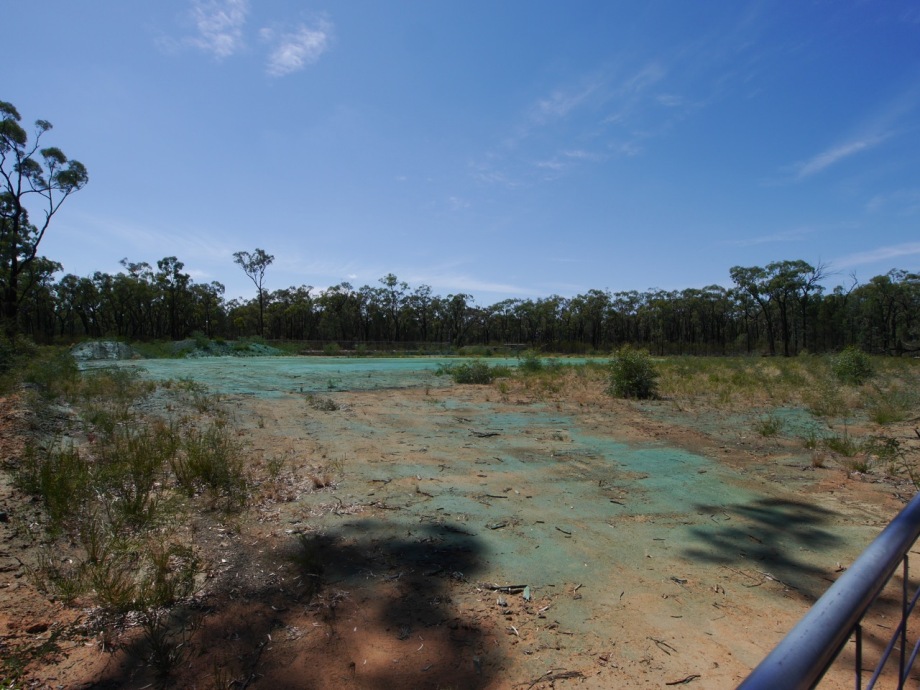
A WELL SITE READY FOR DRILLING, WITH GREEN POLYMER SEALANT ON THE GROUND
Later, directional boring equipment is brought in and one or more fracking holes are drilled horizontally out through the various coal seams to release the gas. The fluids pumped in under high pressure are designed to react and stress the coal seam such that it fractures and releases the minute pockets of methane trapped within, which flow back up the drill holes to the surface for collection. Coal seams always contain a mix of nasties not normally welcome on the surface of the planet. Even open cut coal mines do this (25) , though not often admitted by the industry. Horse breeders and wine growers in the Hunter Valley have tried to get governments to take the threat of these contaminants seriously, with limited success (26). Alan Jones is even on the case.
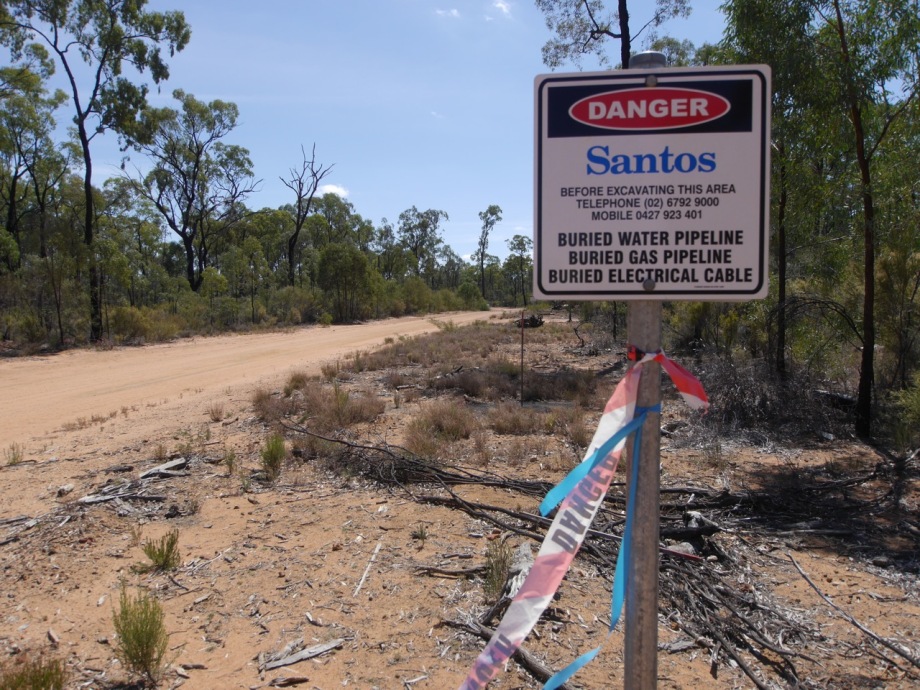
SIGNS, SIGNS, EVERYWHERE THE SIGNS
The productive wells we saw had a satellite dish to allow remote monitoring, at least one gas-fired generator and two diesel generators, and smattering of water separating equipment and miscellaneous bits and pieces, all contained within a secure barbed wire fence. The generators were running at every active site we visited, making power to run the well. One of the tour group remark sarcastically that at least it’s good to see so many locals working at the sites: there was not one person to be seen at any of the five sites we visited, except for a lone security guard at the gates at Leewood. So much for massive local employment (27). It certainly didn’t help save the old Narrabri hardware business Logan’s Mitre 10, which shut its doors in mid 2015, after 63 years (28).
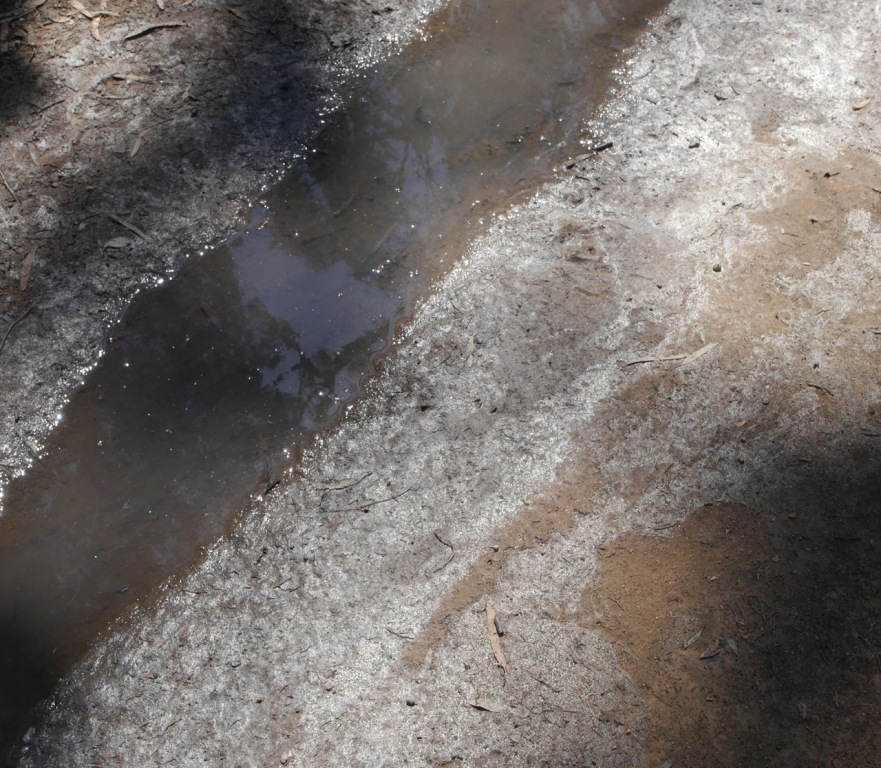
SALINE AND CERTAINLY TOXIC WATER ON A PILLIGA FOREST ROAD
Because Santos’ Pilliga project is in “exploration phase”, no gas can be sold. So all of the gas currently coming up in the operational wells is simply flared off, burnt in open atmosphere with flames up to 4m high. This is done to “prove the resource” to potential investors. But worse, because the gas has not been cleaned, it contains traces of BTEX, uranium, and other radio-nuclides, which makes the burnt vapour hazardous to human health (29) . So our guide was quick to move us along whenever the wind turned the flame toward us. The risk of leaves and bark being blown through these flames on a high risk bushfire day is what concerns the fire fighters (30). They would get little comfort from the 1,000 litre water trailer sitting idly by the gas flare, which is the main plank in Santos’ fire-fighting contingency plan.
GAS FLARE AT A PRODUCTIVE WELL HEAD, WITH 1,000 LITRE WATER CART READY TO EXTINGUISH A WHOLE FOREST ON FIRE
At the beautifully named Bibblewindi water treatment plant we witnessed first hand the worst ecological disaster to hit the Pilliga to date. A swathe of bush about 50 metres wide and several hundred metres long was killed and the ground poisoned when the turkey-nest holding tank broke its banks in 2011. Our guide explains that in an attempt to rehabilitate the area, the topsoil has been removed, the exposed soil mulched, replanted, and long irrigation lines feed it with town water trucked in from Narrabri. Yet five years later it is self-evident that nothing is growing except four or five spindly weeds – it is a wasteland still. Santo’s predecessor Eastern Star Gas were then in control, and reported to the EPA that 10,000 litres of ‘produced water’ had escaped (31).
It seems extremely unlikely that 10,000 litres would have spread so far – it seems more likely from simple observation that the volume must have been far greater. Santos did not cause that spill – that was on the watch of former National Party leader and Deputy Prime Minister John Anderson, who walked out of a political career supposedly representing the interests of farmers and foresters, straight into the boardroom of Eastern Star Gas. He then orchestrated its takeover by Santos, no doubt without suffering any personal disadvantage (32) .
TOXIC SPILL SITE AT BIBBLEWINDI FIVE YEARS ON
LAND, WATER, FUTURE
I have walked, often barefoot, in virtually every part of Australia: the Red Centre, the Kimberley, Southwest WA, the Nullabor, the Tanami Desert, the Great Dividing Range, even the Overland Track in Tasmania. Never before have I been scared of the ground I walked on, never before felt the land was out to get me. I couldn’t get out of beautiful sounding Bibblewindi quick enough. But all the damage and potential damage I have seen around the Pilliga gasfield is small beer compared to south-east Queensland, where the patchwork hell of unbridled CSG mining has ruined vast swathes of country (33), where the Condamine River bubbles methane(34), where children get nosebleeds if the wind blows the wrong way while they sleep in their beds (35). This all causes a deep upwelling of anger in me – that such damage could be so willfully or negligently caused to this beautiful land, my land, my country. It stirs me - stirs me deep down. And I’m not even Aboriginal.
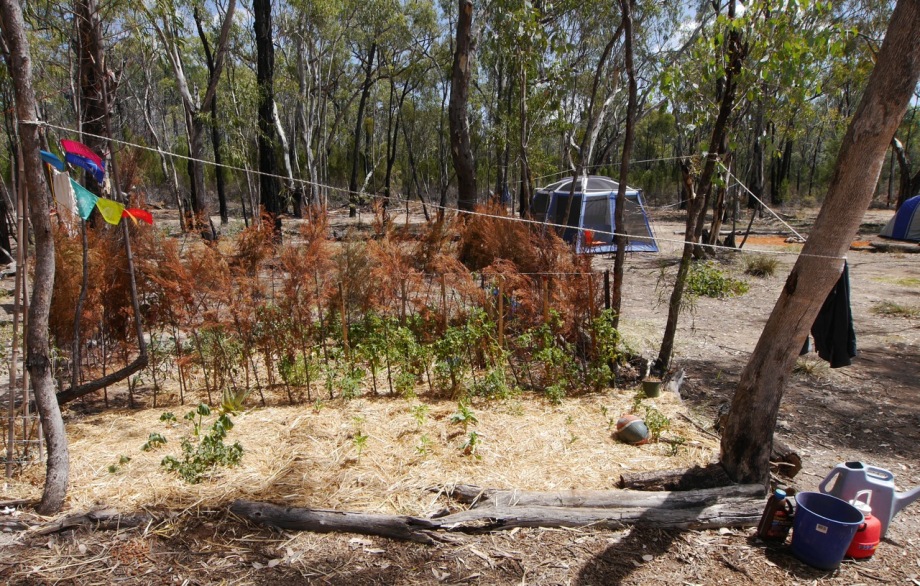
POP-UP VEGIE PATCH WITH WALLABY-PROOF CYPRESS PINE FENCE
We left the Pilliga in the afternoon after a cold lunch in the hot shade of a magnificent old Narrabri river red gum, and headed south via Gunnedah. A sign on the way into town proudly announces "Welcome to Gunnedah - koala capital of the world". Put aside the slight absurdity that the rest of the world could possibly compete for the title - they are in fact referring to the wooded hills south of town, on our right as we drove south with the Breeza Plains, rich black soil and beautiful, on our left, shining in the afternoon sun. These are the very hills that will be obliterated by the Shenhua coal mine (36) - and half the world title-winning koalas with them (37) . It’s another battle, another story, for another time maybe. But why so many battles to save this land, this water, this future? Why now? Or was it ever thus, that people had to fight marauding invaders?
This is a fight we cannot lose. CSG must be stopped, now, permanently. Mike Baird’s new “eco-fascist” (38) laws may jail farmers and nannas who stand against destruction of land, water, future (39). But these people stand up for a higher law, an over-arching morality, and they will not stop standing up for what is right. I think I will stand with them.
BOHENA CREEK RUNS THROUGH THE HEART OF THE PILLIGA SCRUB
1. Hydraulic Fracturing in Coal Seam Gas Mining: The Risks to Our Health, Communities, Environment and Climate, Dr Mariann Lloyd-Smith and Dr Rye Senjen, September 2011
2. Griffiths, Lynne. Conflict over water use in the Liverpool Plains / Namoi River region of the Murray-Darling Basin, Interaction, Vol. 41, No. 2, Jun 2013: 26-31.
3. AGL pulls out of coal seam gas across Australia, leaving farmers ‘ecstatic’. February 4, 2016. Michael Slezak. The Guardian - Australia edition. Retrieved from: http://www.theguardian.com/environment/2016/feb/04/agl-pulls-out-of-coal-seam-gas-across-australia-leaving-farmers-ecstatic
4. Our Land, Our Water, Our Future. Webpage of 'Map of coal in NSW': http://www.landwaterfuture.org.au/nsw_coal_map
5. Dreams dashed after CSG experience. January 16, 2015. Michele Jedlicka. The Inverell Times. Retrieved from: http://www.inverelltimes.com.au/story/2820934/dreams-dashed-after-csg-experience/
5. Defending the Pilliga in Court. By EDO NSW CEO/Principal Solicitor Sue Higginson. 21 January 2016. Retrieved from: http://www.edonsw.org.au/defending_the_pilliga_in_court
6. Pilliga Forest. The Wilderness Society webpage. Retrieved from: https://www.wilderness.org.au/campaigns/pilliga-forest
7. Pilliga Forest. The Wilderness Society webpage. Retrieved from: https://www.wilderness.org.au/campaigns/pilliga-forest
8. Pilliga Forest. The Wilderness Society webpage. Retrieved from: https://www.wilderness.org.au/campaigns/pilliga-forest
9. Protesters arrested in Pilliga Forest. February 8, 2016. Taylor Jurd. Westeran Magazine. Retrieved from: http://www.westernmagazine.com.au/story/3712920/protesters-arrested-in-pilliga-forest/
10. Defending the Pilliga in Court. By EDO NSW CEO/Principal Solicitor Sue Higginson. 21 January 2016. Retrieved from: http://www.edonsw.org.au/defending_the_pilliga_in_court
11. We’re not alone claim: anti-csg stance. February 2, 2016. The Northern Daily Leader. Retrieved from: http://www.northerndailyleader.com.au/story/3703333/were-not-alone-claim-anti-csg-stance/
12.The Zero Carbon Australia Stationary Energy Plan. https://bze.org.au/zero-carbon-australia/stationary-energy-plan
and
Greenhouse Solutions with Sustainable Energy, Mark Diesendorf, University of New South Wales Press, 2007.
13. NASA Releases Detailed Global Climate Change Projections. June 9, 2015. NASA. Retrieved from: http://www.nasa.gov/press-release/nasa-releases-detailed-global-climate-change-projections
14. INSTITUTE FOR ENERGY ECONOMICS AND FINANCIAL ANALYSIS. Retrieved from: http://ieefa.org/author/tim/
and
16. CSG industry hires well-connected staffers. May 25, 2015. Anne Davies. Senior Reporter. Sydney Morning Herald. Retrieved from: http://www.smh.com.au/nsw/csg-industry-hires-wellconnected-staffers-20150515-gh2rg3.html#ixzz431nPd3Hy
17. Inquiry into performance of the NSW Environment Protection Authority – a submission to the NSW Parliament by Tony Pickard, 27 August 2014; and an open letter from Tony Pickard, April 21, 2012: https://www.facebook.com/permalink.php?id=131364620289769&story_fbid=275351795891050
18. Defending the Pilliga in Court. By EDO NSW CEO/Principal Solicitor Sue Higginson. 21 January 2016. Retrieved from: http://www.edonsw.org.au/defending_the_pilliga_in_court
19. Measured by this writer at published scale on Google Earth.
20. Santos CSG flaring on the Pilliga makes a mockery of 'total' fire ban. December 8, 2015. Lachlan Barker. Independnat Australia. Retrieved from: https://independentaustralia.net/environment/environment-display/santos-csg-flaring-on-the-pilliga-makes-a-mockery-of-total-fire-ban,8468
and Flares stoke local anger. December 10, 2015. The Northern Daily Leader. Retrieved from: http://www.northerndailyleader.com.au/story/3549945/flares-stoke-local-anger/
21. Joyce to sell land in 'mongrel country' at site of CSG boom. August 25, 2013. Heath Aston. The Sydney Morning Herald. Retrieved from: http://www.smh.com.au/federal-politics/political-news/joyce-to-sell-land-in-mongrel-country-at-site-of-csg-boom-20130824-2sifm.html
22. Siding Spring observatory under threat from coal seam gas light pollution. October 21, 2014. Oliver Milman. The Guardian - Australia edition. Retrieved from: https://www.theguardian.com/science/2014/oct/21/siding-spring-observatory-threat-coal-seam-gas-light-pollution
and
Light Pollution Stories Not Illuminating The Whole Picture At Siding Spring. December 27, 2015. Retrieved from: https://www.coonabarabran.org/coonabarabran-news/light-pollution-stories-not-illuminating-the-whole-picture-at-siding-spring/
23. Police in 'rare' use of pepper spray in anti-Santos CSG fight, protesters say. February 2, 2016 Peter Hannam. Environment Editor, The Sydney Morning Herald. Retrieved from: http://www.smh.com.au/environment/police-in-rare-use-of-pepper-spray-in-antisantos-csg-fight-protesters-say-20160202-gmjo49.html#ixzz431jVwpcX
24. Hydraulic Fracturing in Coal Seam Gas Mining: The Risks to Our Health, Communities, Environment and Climate, Dr Mariann Lloyd-Smith and Dr Rye Senjen, September 2011
25.A Survey of Naturally Occurring Radioactive Materials Associated with Mining, Long, Sdraulig, Tate and Martin, Australian Radiation Protection and Nuclear Safety Agency Technical Series Report N. 161, August 2012, Australian Government.
26. The unlikely activists taking on Old King Coal. October 25, 2013. Tom Morton,. ABC Radio National. Retrieved from: http://www.abc.net.au/radionational/programs/360/5043744
27. Santos: https://narrabrigasproject.com.au
28. Doors close at Narrabri Mitre 10 after 63 years of business. July 14, 2015. The Courier. Narrabri Shire. Retrieved from: http://www.thecourier.net.au/news/doors-close-at-narrabri-mitre-10-after-63-years-of-business/
29. Chief Scientist CSG report leaves health concerns unanswered. October 8, 2014. Melissa Haswell, Associate Professor (Public, Environmental and Indigenous Health), Muru Marri, School of Public Health and Community Medicine, UNSW Australia and David Shearman, Emeritus Professor of Medicine, University of Adelaide. The Conversation. Retrieved from: https://theconversation.com/chief-scientist-csg-report-leaves-health-concerns-unanswered-32422
30. Santos CSG flaring on the Pilliga makes a mockery of 'total' fire ban. December 8, 2015. Lachlan Barker. Independnat Australia. Retrieved from: https://independentaustralia.net/environment/environment-display/santos-csg-flaring-on-the-pilliga-makes-a-mockery-of-total-fire-ban,8468
31. Eastern Star Gas fined for pollution in the Pilliga. Media release: 6 July 2012: Environmental Protection Authority (EPA): Retrieved from http://www.epa.nsw.gov.au/epamedia/EPAmedia12070601.htm
32. Anderson out of gas if Santos steps up. July 19, 2011. Clancy Yeates. The Sydney Morning Herald. Retrieved from:
http://www.smh.com.au/business/anderson-out-of-gas-if-santos-steps-up-20110718-1hllp.html
33. Aerial photo of coal seam wells. August 4, 2014. ABC News Online. Retrieved from: http://www.abc.net.au/news/2014-08-04/aerial-photo-of-coal-seam-wells/5647642
36. Shenhua coal mine: Controversial Liverpool Plains project 'unlikely' to go ahead, Government sources say. Lucy Barbour. ABC News Online. 19 February, 2016. Retrieved from http://www.abc.net.au/news/2016-02-17/shenhua-unlikely-to-go-ahead/7177270
38. "An Act to amend the Inclosed Lands Protection Act 1901, the Crimes Act 1900 and the Law Enforcement (Powers and Responsibilities) Act 2002 in relation to interference with mining and other businesses or undertakings". Date Passed with amdts: Wed 16 Mar 2016 See the Bill - New Law HERE
39. Tough new protesting laws could target Knitting Nannas. Chris Calcino. March 9, 2016. The Northern Star. Retrieved from http://www.northernstar.com.au/news/lock-up-your-nannas-or-we-will/2956532/